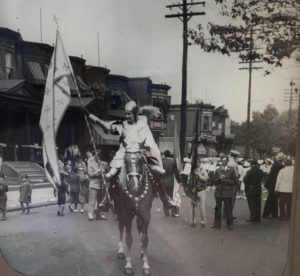 Msgr. Edward Hawks was born Feb 17, 1878 in Southern Wales. He moved to Canada to study for priesthood in the Anglican church. During the Open pulpit controversy, he converted to Catholicism and was ordained by Archbishop Prendergast in 1911. He served as a chaplain in the Canadian Expeditionary Force during World War I and later served as a Vatican observer during the Spanish Civil War. Hawks wrote extensively and often gave lectures on history and current events. Thanks to these records much of the history of St. Joan of Arc can be told in his words.
Msgr. Edward Hawks was born Feb 17, 1878 in Southern Wales. He moved to Canada to study for priesthood in the Anglican church. During the Open pulpit controversy, he converted to Catholicism and was ordained by Archbishop Prendergast in 1911. He served as a chaplain in the Canadian Expeditionary Force during World War I and later served as a Vatican observer during the Spanish Civil War. Hawks wrote extensively and often gave lectures on history and current events. Thanks to these records much of the history of St. Joan of Arc can be told in his words.
Father Hawks was appointed by Archbishop Dennis Dougherty to found a new parish on Oct 1, 1919. To which he wrote “to be a pastor is the dearest ambition of almost every priest, to be a good pastor is to reach the greatest glory of the priesthood”
The first issue for Hawks was the name of his new parish:
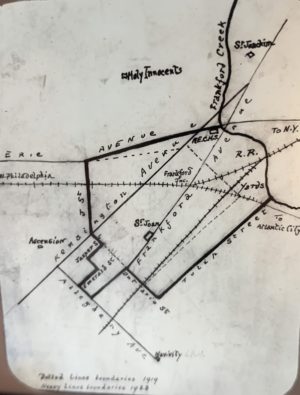 “The parish was yet unmade. For me there was only one desirable name – a named beloved of every soldier who had been at the front. It was a possibility but not a probability. Saint Joan of Arc had not yet been canonized. However, during a meeting of the consultors of the diocese, the name of the new parish was needed. The Chancellor rung me up to obtain the desired information. I told him without a moment’s hesitation that its name was St. Joan of Arc; and this it became from that moment.”
“The parish was yet unmade. For me there was only one desirable name – a named beloved of every soldier who had been at the front. It was a possibility but not a probability. Saint Joan of Arc had not yet been canonized. However, during a meeting of the consultors of the diocese, the name of the new parish was needed. The Chancellor rung me up to obtain the desired information. I told him without a moment’s hesitation that its name was St. Joan of Arc; and this it became from that moment.”
The next challenge was acquiring the land where the parish buildings were to be constructed
“Six parcels had not yet been purchased. It was important that no hopes of enhanced values should be aroused in the mind of the owners. It was therefore dangerous to visit the location.”
By the beginning of November, only one property remained unpurchased and it refused to sell until the 1930s. However, the parish had acquired enough land for future buildings.
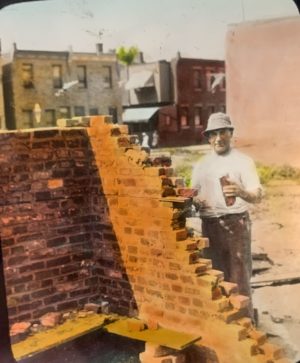 While St. Joan of Arc Parish took portions from Nativity, Ascension and St. Joachim, its original boundaries were quite small. It ran from Buckius Street to Sepviva then to Ontario and then to J Street. In fact the southern boarder was only two blocks from the where the church was to be built. Adding to the difficulty was that much of the area was mills and other industry and most of the families that lived in the area poor so raising funds for building the church would prove an issue.
While St. Joan of Arc Parish took portions from Nativity, Ascension and St. Joachim, its original boundaries were quite small. It ran from Buckius Street to Sepviva then to Ontario and then to J Street. In fact the southern boarder was only two blocks from the where the church was to be built. Adding to the difficulty was that much of the area was mills and other industry and most of the families that lived in the area poor so raising funds for building the church would prove an issue.
Hawks quickly set up a temporary chapel located in a house with an old store front that could fit sixty people. The first Mass was said on November 23.
“the crowd filled the backyard, the passages, the stairs, and even the living rooms above. So large was the assembly on the sidewalk that many passersby thought that a tragedy had taken place. In order to preserve a moral unity in the congregation, the electric bells throughout the house were rung at the various parts of the service, and the priest who was not officiating stood in the hall and recited the Mass in English. The gospel and the notices were read on each floor.”
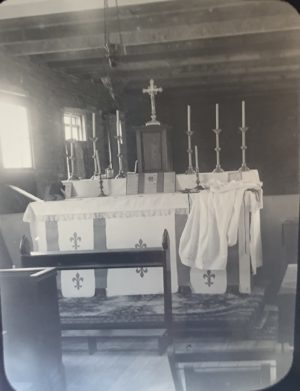 The chapel moved to June 27, 1920 to an old blacksmith shop on the property once the blacksmith moved out.
The chapel moved to June 27, 1920 to an old blacksmith shop on the property once the blacksmith moved out.
However of this new location Hawks wrote “it was totally inadequate; if anything it was worse than the store. One thing was certain, the chapel had to be enlarged as soon as possible.” Hawks told his parishioners that “we need any man who can drive a nail for this to work.”
As was common in the archdiocese, parishes were encouraged to quickly open a school. The first school for St. Joan of Arc had humble beginnings.
“On the corner of Frankford road and Atlantic street stood a dilapidated three-story building. The windows were out, the roof leaked and the floors were dangerous. Entering the building was a risky matter, since the lower floor was actually fallen in places and the cellar was full of vermin. When Mother Isador of the Sisters of the Immaculate Heart of Mary called to see me with reference to the future school she happened to notice this wretched building. “there’s your school,” she exclaimed. I was dumbfounded. She gathered up her skirts and went over the premises, even going up to the top of the third floor. She assured me that a school of the six lower grades could, and therefore should, be started at once. This was on July 23rd. We needed money at once. A monster carnival on the school lot was held it was attended by vast crowds. The tables that made the most money were those which chanced off hams and groceries. The carnival provided $8,000. The whole sum was needed before the ruined house was rehabilitated.” The school was ready by September 8th. It opened with 182 children.
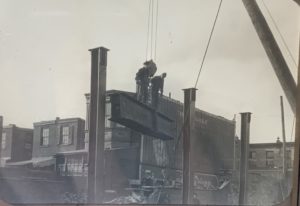 Hawks quickly began planning a larger combined church/school. On November 20, 1921 the ground was formally broken. “The winter was very mild and it was possible for the stone masons to lay the heavy foundations in the early part of January. Throughout the month of February the brickwork progressed like magic, whilst the great steel columns and beams were being erected. We left a portion of the wall at the south-western corner below level so that the solemnity of the corner stone laying might take place in faith weather. Bishop Crane officiated on Palm Sunday 1922. A large crowd estimated from 5,000 to 10,000 blocked all the approached to the new school. By the end of May the brickwork was finished and in another month the roof was on.”
Hawks quickly began planning a larger combined church/school. On November 20, 1921 the ground was formally broken. “The winter was very mild and it was possible for the stone masons to lay the heavy foundations in the early part of January. Throughout the month of February the brickwork progressed like magic, whilst the great steel columns and beams were being erected. We left a portion of the wall at the south-western corner below level so that the solemnity of the corner stone laying might take place in faith weather. Bishop Crane officiated on Palm Sunday 1922. A large crowd estimated from 5,000 to 10,000 blocked all the approached to the new school. By the end of May the brickwork was finished and in another month the roof was on.”
The church was to be on the first floor and schoolrooms on the next two. On July 2, the first Mass was said in the new building. Work continued on the classrooms which would be ready for September 1923. When the new building opened, attendance had increased to nearly 400 children and would grow to over 600 by 1932.
 During the construction of the church, Hawks commissioned a statue of St. Joan of Arc to be erected. Originally, they tried to get the actress, Ingrid Bergman to model for the statue of St. Joan of Arc since she was playing the saint in a production on Broadway. Hawks and others even went up to New York to try to meet her after one of her performances. While she was very excited about the idea , she ultimately decided not to sit as the model because “wouldn’t it be a terrible thing if I ever got into a scandal? I can just see them tearing down poor Joan and smashing her to pieces.”
During the construction of the church, Hawks commissioned a statue of St. Joan of Arc to be erected. Originally, they tried to get the actress, Ingrid Bergman to model for the statue of St. Joan of Arc since she was playing the saint in a production on Broadway. Hawks and others even went up to New York to try to meet her after one of her performances. While she was very excited about the idea , she ultimately decided not to sit as the model because “wouldn’t it be a terrible thing if I ever got into a scandal? I can just see them tearing down poor Joan and smashing her to pieces.”
Msgr. Hawks remained as pastor until his death in 1955 and the parish would remain an important feature of the community until it closed in 2013.

